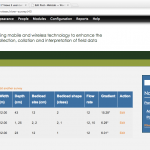
Today’s lesson learned was about Drupal, the content management system we’re using for handling field data…
Chris and I had gotten to a stage where we can add data to the site using a web form as part of a river survey activity. This is great – data is being collected – but we were not entirely certain where it was going or how to get it back. The next step was to create a view that would show what’s been collected so far. Again, not rocket science as in theory we’ve done this type of thing previously, but it was a bit tricky as we used a field type called ‘field collection’ that we had not used before. The field collection lets us add multiple values for something, for example…
We have used a taxonomy to store the name and images of the creatures the students will be looking out for when they carry out a pond survey. We added fields to also store Feeding level, Type of feeding, Description and Latin name – these fields could be displayed for different levels of user. We specifically wanted the view to be easy to use, so a thumbnail image of each creature is used to move on to the next screen, which is the input form. We then make use of the Entity Reference Prepopulate module to set three of the selectors in the form based on: the group the user is in, the pond environment they have previously selected, the creature they have just selected.
Today I tried to see if I could work out the battery power savings from closing the laptop (a Lenovo IdeaPad U310 with an intel i5 processor, running Ubuntu 12.05 LTS Desktop). I’ve always been surprised when the laptops and netbooks we use as field servers seem to last longer than the estimated battery time […]
Today I set up a Lenovo U310 laptop with Ubuntu and installed the web server software (i.e. Apache, PHP5 and MySQL). The process was not too painful and so far the standard Ubuntu 12.04 LTS Desktop installation seems to be running really well on the laptop. Here’s the process I followed… 1. Switch the Lenovo […]